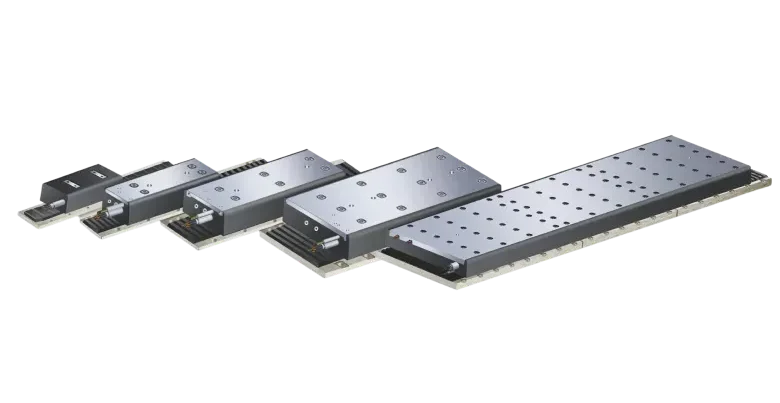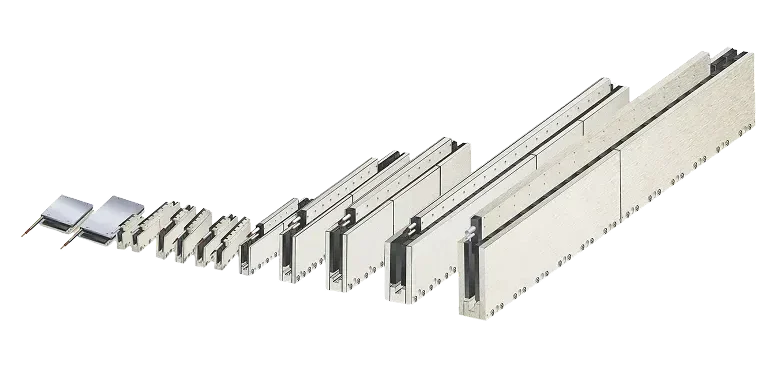How Does a Linear Motor Work?
How does a linear motor work? It uses electromagnetic forces to produce direct linear motion, eliminating rotary parts for fast, precise, and smooth movement.
What Is a Linear Motor?
A linear motor is an electric motor that generates motion in a straight line rather than rotational motion. Unlike traditional motors that rely on mechanical components to convert rotation into linear displacement, linear motors eliminate intermediate mechanisms, providing direct, precise, and high-speed movement.
If you’re wondering what is a linear motor, it’s essentially a rotary motor “unrolled” and laid flat, allowing the moving part (the forcer) to glide along a linear track powered by electromagnetic force.

Linear Motor
4 Key Components of a Linear Motor
To fully grasp how does a linear motor work, it’s essential to understand the core components that enable its precise and frictionless motion. Although designs may vary across motor types, most linear motors share the following fundamental elements:
1. Stator (Primary Part)
The stator contains coils of wire through which electric current flows. This section generates the traveling magnetic field that drives the linear motion. In most configurations, the stator is the stationary part, mounted along the machine’s base.
2. Forcer or Slider (Secondary Part)
Also known as the moving part or armature, the forcer reacts to the magnetic field generated by the stator. It contains magnets or coils (depending on motor type) and moves linearly in response to electromagnetic forces. In some designs, the slider moves while the stator remains still; in others, it’s the opposite.
3. Linear Guide or Track
To ensure precise movement and mechanical support, a linear guide system is often used alongside the motor. This helps maintain alignment and reduces the risk of mechanical instability during high-speed motion.
4. Feedback System (Encoder)
High-performance linear motors typically integrate a linear encoder, a sensor that constantly monitors the position of the moving part. This feedback allows for closed-loop control, ensuring pinpoint accuracy, synchronization, and repeatability.
These components work in harmony to deliver smooth, direct motion without the need for traditional transmission elements like gears, belts, or screws. Together, they form the backbone of what makes linear motors a powerful solution in modern automation.
Understanding this fundamental concept is essential before diving deeper into how does a linear motor work, which we’ll explore in the next section.
The Core Principle Behind Linear Motor Operation
To understand how does a linear motor work, we need to look at the fundamental principle that drives it: electromagnetic force applied in a straight line. At its core, a linear motor operates on the same principle as a traditional rotary motor – Lorentz force – but instead of generating rotational torque, it creates direct linear thrust.
When current flows through the motor’s stator coils, it interacts with the magnetic field, producing a traveling magnetic wave. This wave propels the moving part (the forcer or slider) along a straight path.
Think of it as unfolding a rotary motor and laying it flat. The circular magnetic rotation becomes a linear magnetic wave that “pulls” or “pushes” the forcer along the axis. This conversion eliminates the need for screws, belts, or gears, reducing mechanical losses and enabling faster, more precise motion.
This elegant mechanism is what makes high precision linear motors ideal for applications requiring high-speed, high-accuracy, and low-maintenance motion, qualities increasingly demanded in today’s automation-driven world.
How Does a Linear Motor Work?
Linear motors come in several different types, each designed to meet specific application requirements in terms of speed, force, precision, and structure. Understanding these variations is key to seeing how does a linear motor work across industries.
1. Iron-Core Linear Motors
These are among the most powerful and commonly used linear motor types in heavy-duty applications.
How they work: An iron-core linear motor consists of copper windings wrapped around laminated iron cores. When electrical current is applied, these windings interact with permanent magnets mounted on the track, producing strong electromagnetic force that propels the slider. The iron core acts as a magnetic conduit, amplifying thrust while maintaining compact size.

IronCore Linear Motor
Advantages & Use Cases:
- High continuous and peak force capabilities
- Efficient thermal performance due to strong magnetic coupling
- Ideal for CNC machines, plastic injection systems, and automation lines where brute force and durability matter
- Downsides include potential cogging and higher mass, which can affect motion smoothness
This type is a textbook case of how does a linear motor work when power and force take priority.
2. Ironless (Air-Core) Linear Motors
Designed for finesse and speed, ironless motors deliver motion with virtually zero friction or ripple.
How they work: Unlike iron-core variants, air-core linear motors have no ferromagnetic material in the moving part. Instead, coils are suspended between two magnet tracks, “floating” in a magnetic field. As current flows through the coils, the resulting force drives the slider without any cogging or magnetic pull.

Ironless (Air-Core) Linear Motors
Advantages & Use Cases:
- Exceptionally smooth and precise motion
- Low moving mass enables rapid acceleration and deceleration
- Extremely low heat generation and electromagnetic interference
- Common in cleanroom environments such as semiconductor fabs, medical devices, and optical inspection systems
These motors are the best demonstration of how does a linear motor work when micro-precision and responsiveness are top priorities.
Products Linear Motor ITG:
https://itg-motor.com/what-is-an-ironless-linear-motor-and-ironcore-linear-motor/
https://itg-motor.com/what-is-a-linear-actuator-motor-different-from-a-linear-motor/